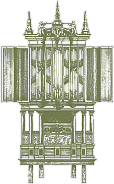Restoration on the basis of organ archaeology
Before we restore an organ, we examine it (its casing and its component parts) thoroughly. How were different parts attached? Can we still see signs of these, such as nail-holes or discolourations? How are the parts connected to one another? What inscriptions do they bear? Such detective work, we combine with our historical and musical knowledge and the research already done in the archives. The knowledge we acquire through it forms the basis for the (decisions taken during the) restoration.
“The broader the palette of historical knowledge and experience, the easier it is to recognize and assign the historical parts of the organ.”
In the service of our heritage
The restoring of a heritage-protected instrument requires that we put ourselves at its service. In the end, we don’t want to improve it or make it better as we understand “better”. Rather, we want to preserve or restore, in their entirety, the organ’s special qualities, the acoustic idiom that is unique to it, its fundamental values. This means we have to apply, to every organ, all our comprehensive knowledge and our long experience with organs from all the different periods of history.
“The sound is charismatic, emotional and poetic. Thanks to Flentrop’s restoration, the organ gained great power of musical expressiveness.”
Aart Bergwerff, consultant on the Hinsz organ in the Grote Kerk, Bolsward
Choice of materials: a historical perspective
We are careful to orient our choice of materials by the materials already contained in the organ and the historical facts about it. Does the instrument feature pipes from different periods made by different organ-builders? Then we closely investigate how the material for these pipes was hammered, cast, polished or scraped. We establish the thickness of the walls and how they run, the treatment of the organ surfaces and the composition of the substances used to treat them.
Once we have exactly established the materials, we can then determine the best way of restoring them. This knowledge also helps us to reproduce as closely as possible, in our own workshops, the methods of manufacture that had produced the original materials. This is why we cast our pipe metal on sand since 2008.
"In Mölln we saw that the pipes made by Köster had been scraped transversally, but those made by Scherer longitudinally. Stellwagen’s pipes had been scraped with a very fine, sharp scraper. The Gothic pipework had been crudely hammered with heavy, deep hammer-strokes and then crudely scraped in all directions. This insight into the specific traits of the materials also helped us to tell apart from one another the pipes without inscriptions. We were able, in our workshop, to separate out the material originating respectively from each of these historical organ-builders and restore it using his methods, so that the restored pipework matches in every respect the historical one and sounds exactly the same."
Steps and procedures in restoration
Seeing and hearing
Analysis and plan
Disassembly
Repair according to plan
Reassembly
Voicing and sound refinement
Execution guidelines of the “recognized restoration quality” foundation
In all our restoration projects we work in compliance with the (globally) recognized Execution Guidelines on Historical Organs of the Dutch Society for Recognized Restorational Quality for Heritage Purposes (uitvoeringsrichtlijn historische orgels van de Stichting Erkende Restauratiekwaliteit Monumentenzorg) (URL 7010 of the ERM). Flentrop contributed actively to the drawing-up of these guidelines. This globally recognized method guarantees that the respective current state of the organ is thoroughly recorded and that careful, measured consideration is given during restoration to when the restorer should conserve, when he should repair and when he should correct. So that the organ, once refreshed, should long remain so, attention is also paid to its environing climate.
Contact
Looking for an expert for your restoration project?
We would like to consult with you.
Interested? Feel free to contact us!
